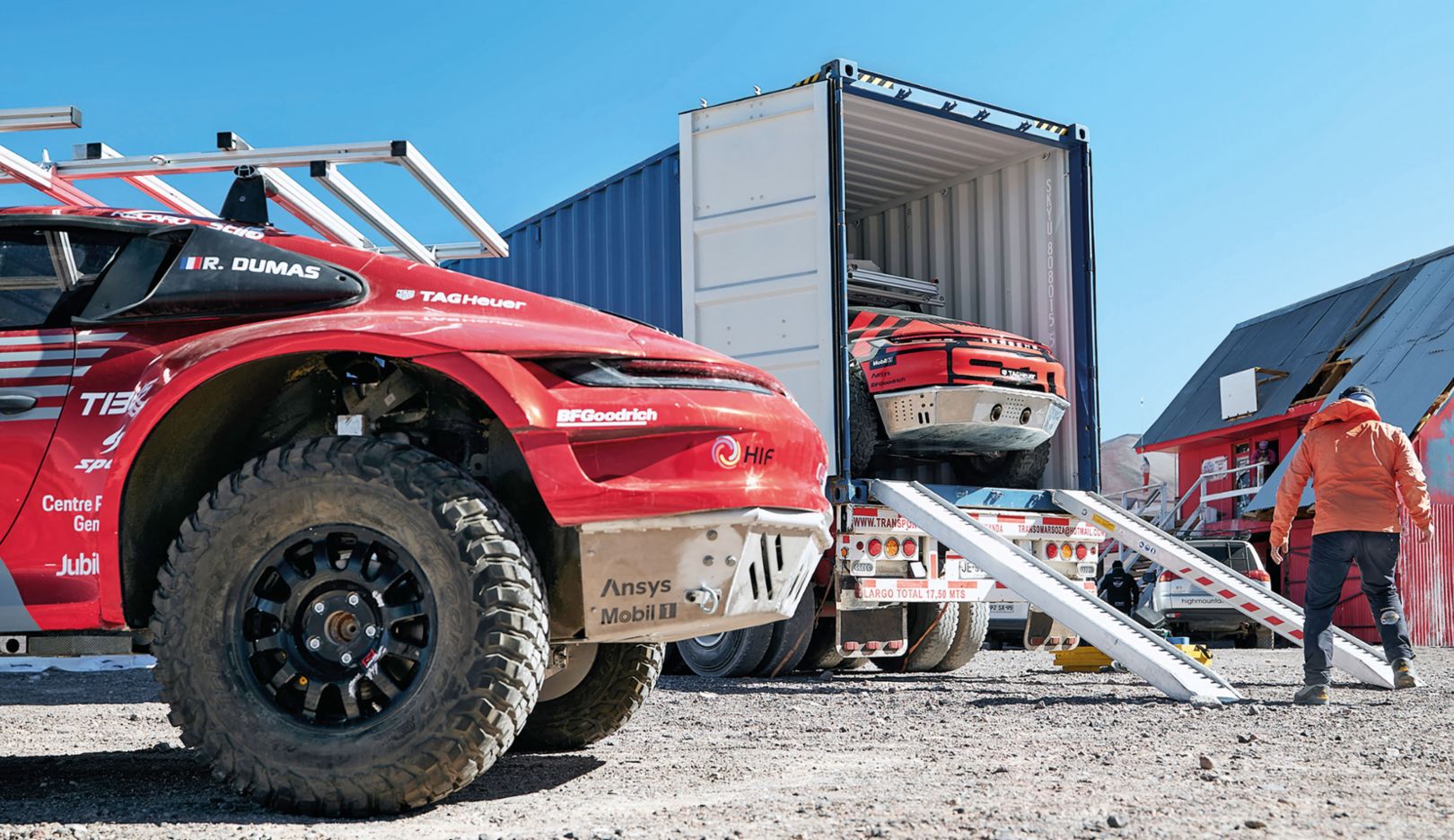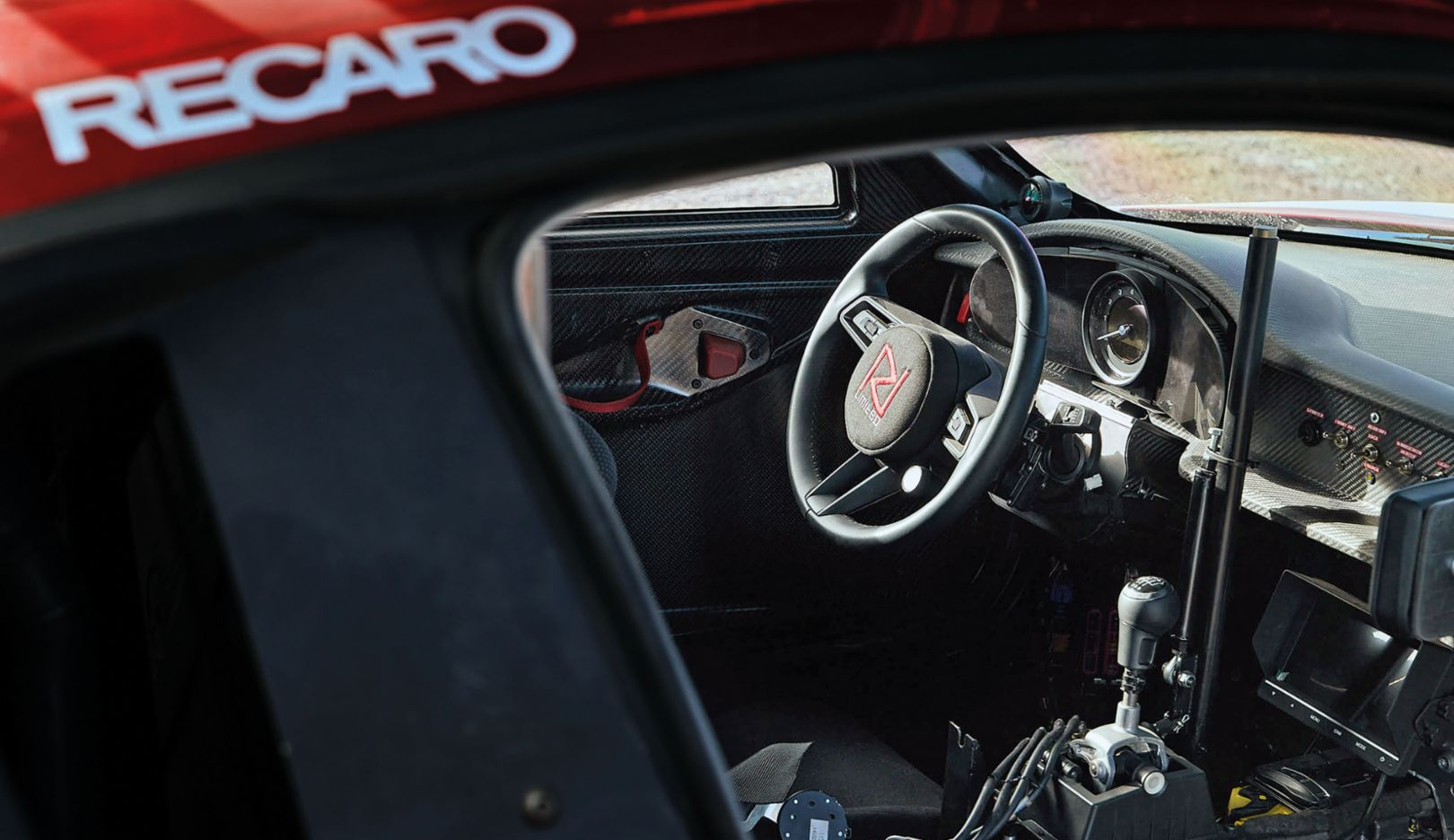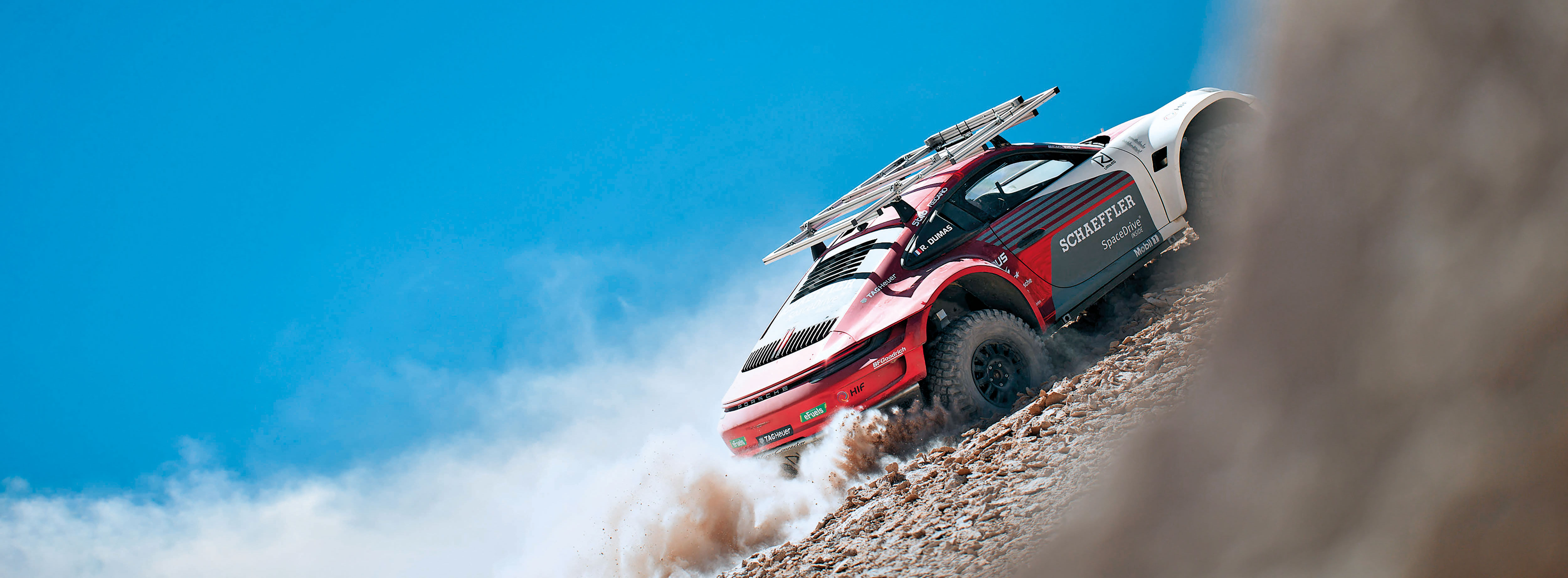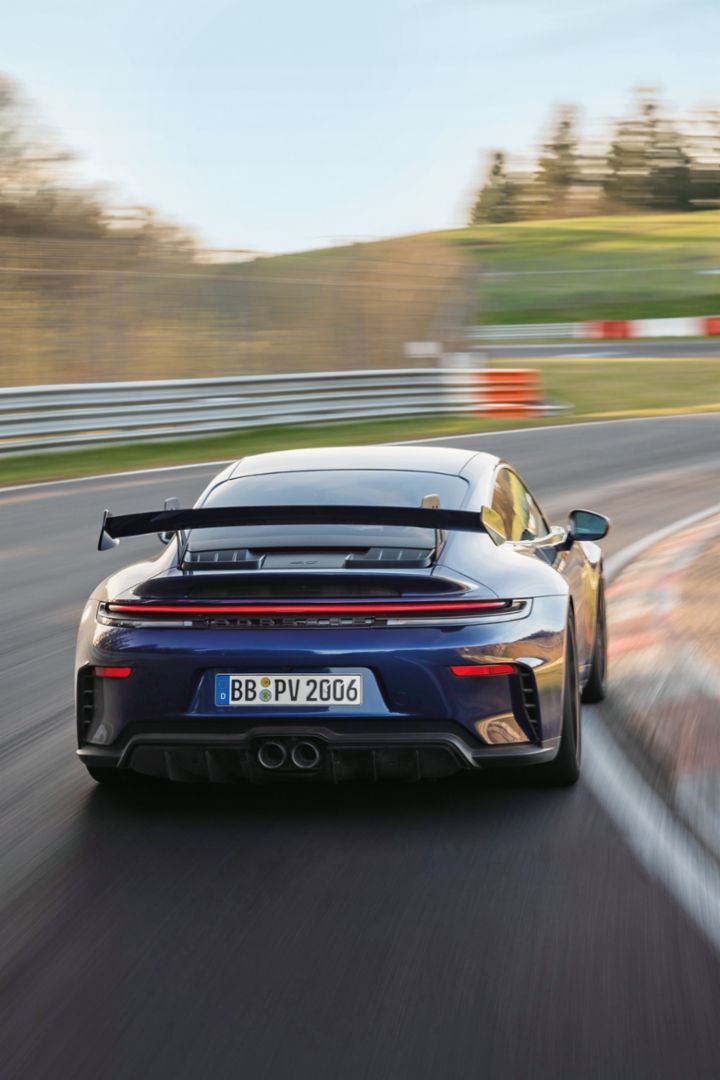High Point
After 60 years of building dreams and breaking records, what next for the inimitable 911? Enter a small team with a big idea, so crazy it just might work …
At 15:00, on a bitterly cold afternoon in December 2023, Porsche works driver Romain Dumas has a decision to make: turn left or turn for home. But there are two catches. Turning around would mean failing to complete a mission four years in the making, and abandoning an agonizing, exhausting three-week-long expedition mere feet from its end. But turning left would mean traversing a narrow sheet of ice on a 45-degree incline, some 6,600 meters above sea level, below which is a near-vertical 500-meter drop. The three-time Le Mans winner and veteran off-road racer finds first gear and feeds in the clutch.

Le Mans winner:
Porsche works driver Romain Dumas and his race team RD Limited supported the mission from 2022.The origins of Dumas’s dilemma can be traced back to a bus journey on the Mediterranean island of Majorca in September 2019. Here, during a Porsche management conference, Frank-Steffen Walliser, then Vice President Model Line 911 and 718, was presented with an idea so outrageous that many in his position would simply have laughed it off. “Why not see if we can drive a 911 higher than any other car in history?”
“I remember very well the idea first being discussed,” says Walliser, who is now responsible for Complete Vehicle Architecture at Porsche. “And straight away I said ‘Let’s go for it.’ It’s in the nature of a sports car manufacturer to go for records, whatever they are.” There then followed three extraordinary months of intensive and secretive development.
Work in a secret lab
What would become known as “Project Kilimanjaro” began in almost complete secrecy. The Ojos del Salado volcano on Chile’s northerly border with Argentina was one of the only places on Earth where such an altitude record was possible, based on the supposition that driving a car to beyond 6,000 meters above sea level was at least theoretically possible. Remote and inhospitable, the mountain was a daunting prospect fraught with unknowns and very real dangers. “After a good deal of discussion, we felt confident we could do it,” Walliser explains. “But we decided not to tell anybody. I did inform Member of the Executive Board responsible for Development Michael Steiner that something was going on, but then we simply went directly to the people we needed.” In early October 2019, a 911 (992) was brought to the workshop to be tested by a team handpicked from across the various Porsche vehicle development divisions. First of all, it was disassembled.

Deployment:
The vehicles “Doris” and “Edith” getting ready for the ascent. Meanwhile, the team prepares the route through hitherto impassable ice fields in freezing temperatures.
The initial team comprised fewer than 30 people, among them Michael Rösler, Vice President Model Line 911; Jens Kayser, Project Manager; and Achim Schulz, Vice President Development Sports Car Axles. As if in a secret lab, they got down to work on the project, operating below the radar but with unusual freedom. The budget was limited, however, so it was decided at the outset to use components from series production cars wherever possible, such as, for example, the 911 Carrera 4S (992) powertrain, assuming the 3.0-liter twin-turbo six-cylinder engine (911 Carrera 4S (2023): Fuel consumption* combined (WLTP) 11.1 – 10.2 l/100 km, CO₂ emissions* combined (WLTP) 253 – 231 g/km, CO₂ class G ) would be capable of operating at altitudes of well over 6,000 meters. “The only way this could be proven was to test the anticipated conditions in an altitude simulation chamber that Porsche had built in the 1980s to develop the PFM 3200 aero engine,” says Michael Rösler. Early tests suggested that only minimal adjustments would need to be made to the 911 engine control unit to provide more than enough power to perform at altitudes of up to 7,000 meters.
The first ascent
The top secret car nicknamed “Doris” in reference to its “off-road independent suspension” made its maiden test-drive just nine weeks after work had begun. Doris rode out on a chassis featuring portal axles, bespoke dampers, and vast off-road tires that combined to offer an astonishing 350 millimeters of ground clearance.

Extreme environment:
On board is an outdoor navigator that logs the altitude and GPS data (above). The warp connector, pictured here in the test car Doris (below), enables the best possible traction with extreme chassis angling. Rare moments of tranquility offer fantastic views.

Achim Schulz was responsible for designing the complete technical concept, which also contains the “warp connector” system. This device was conceived in 2008 during development of the RS Spyder (LMP2) and was originally intended to be used in the Porsche 919 Hybrid (LMP1). “The system all but eliminates vehicle roll while maximizing traction over uneven ground and at extreme chassis angles.” An initial test run in a disused quarry 150 kilometers east of Stuttgart was encouraging: all the systems functioned precisely as intended. Just one week later, at the end of December 2019, the team was on its way to Chile.
This first outing was a trial run, as much for the team as for Doris, with a slow process of acclimatization necessary for the engineers and driver to cope with the extreme altitude and freezing temperatures down to minus four degrees Fahrenheit. Safety was the highest priority, with regular medical checks conducted to monitor the stresses brought about by lack of sleep, lack of oxygen, and the unremitting cold. Except for some readily resolved problems with cooling, the 911 performed faultlessly during this first run up the volcano, and with British off-road driving expert Ian Brown at the wheel, the car managed to pass 6,100 meters before the impending arrival of a horrendous snowstorm stopped its progress.

Icy conditions:
Doris in 2019, at an altitude of over 6,000 meters. The first attempt had to be aborted due to a snowstorm.The wait for the next attempt took on unforeseen dimensions: due to the Covid‑19 pandemic, the team had to wait until the winter of 2022 to return to Chile. And this time, they did so with renewed vigor and a new partner in Porsche works driver and Le Mans winner Romain Dumas and his race team RD Limited.
“I was attracted by the challenge of pushing your own limits.”
Romain Dumas
The allure of the impossible
Dumas and Walliser were old friends, and the race car driver’s passion for extreme motorsport was a clear asset in preparing for a second attempt. “I was attracted by the human challenge of pushing your own limits,” Dumas says. “But also by the development of a sports car that is able to do something that looks impossible on paper.” And the most important thing, Dumas adds, would be preparation, just like in Le Mans. “If you build the right car and the right team, you have a chance of winning.” Working in partnership with the engineers in Weissach, RD Limited began to develop an enhanced sister car for Doris. Christened “Edith,” she was fitted with a much larger winch, requiring the relocation of the cooling system to behind the driver’s seat. Edith was considerably lighter and was equipped with bespoke dampers and wheels that allowed the tires to operate at a reduced tire pressure of just 0.4 bar. Edith also received a unique steer-by-wire system that made it easier for the car to track over the rocky and broken surfaces of the volcano.

Energy:
The 911 was powered by eFuels from the pilot plant “Haru Oni” initiated by Porsche and project partner HIF in Punta Arenas, Chile. Synthetic fuel has been produced there since December 2022.This also reduced the risk of damage to the steering components. The system had the added benefit of absorbing much of the more punishing feedback, something that had proven exhausting for the drivers during long and arduous stints at the wheel.
Dumas was meticulous in the preparation of his team, recruiting respected European mountaineers and Chilean guides alongside a pair of experienced alpine medics. He also had a raft of upgraded expedition equipment that would make the punishing conditions on Ojos del Salado more bearable. Nevertheless, the weather once again had the final say in 2022, and despite both cars proving more than capable of making the ascent, the expedition was aborted for the second time at just past 6,000 meters due to heavy snow and ice.

Reduction:
The interior around the digital instrument cluster in the 911 (992) was essentially gutted to reduce the weight.Finale at the summit
To have come so close and to be forced to return home without the record was a bitter pill for all involved. But after two aborted attempts, it was now a more straightforward task to return: “It was a matter of trust,” says Jens Kayser. “We had the data – we knew we could do it, that the car was good.” In late 2023, the team flew back and began the painstaking process of acclimatization and ascent again. The team struck out once more for the summit at 03:30 on December 2, 2023. This time, the weather was fair and an attempt at the record seemed possible.
And then Dumas was faced with the decision: turn off or abandon the mission? He made his decision, tracking left along the narrow, frozen ridge. He leaned on the lightness and agility of the 911 powered by eFuels to cover ground no other car had ever managed to traverse. Dodging boulders, occasionally crashing right over them, he crossed the 45-degree rock face with grim determination, knowing there was no opportunity to turn back. With a final flurry of acceleration, amid a spray of shingle and volcanic ash, the race car driver and Edith made it to the crest of the western summit of Ojos del Salado. The GPS reading recorded 6,734 meters above sea level, the highest any vehicle has ever been driven anywhere on Earth. A world record!

Mission accomplished:
After 12 tiring days, Edith and the team reached the western summit of the Ojos del Salado volcano in Chile, an incredible 6,734 meters above sea level.
The expedition of their lives:
The small team will never forget “Project Kili.” Together, they made the seemingly impossible possible.“For sure, I was afraid at times,” Dumas says. “There were moments when I asked myself what on earth I was doing there. And past approximately 6,400 meters, I knew that if something went wrong, I would be falling for a very long time.” Turning left before the summit was a point of no return. “But the chassis, performance, and agility of the 911 made something impossible possible.”
And, of course, the people. For four years, they believed in their dream, ventured up on the volcano again and again, conquered hostile terrain – and never lost sight of their goal.
Consumption data
911 Carrera 4S (2023)
911 GT3
-
13.8 – 13.7 l/100 km
-
312 – 310 g/km
-
G Class
Taycan Turbo GT
-
21.2 – 20.5 kWh/100 km
-
0 g/km
-
A Class











